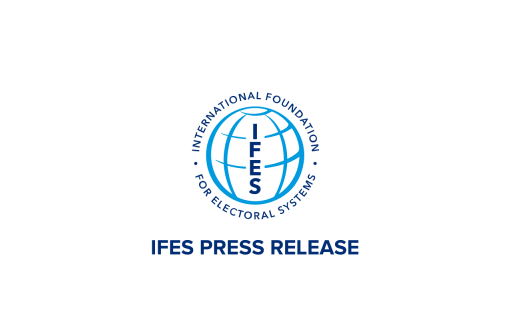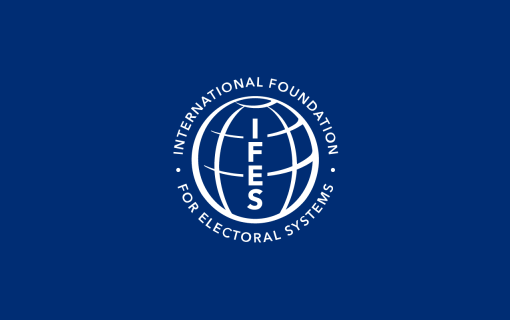In Kenya, Using Technology for Safer Elections
In response to the violence following Kenya's 2007 presidential election, which divided the country and left dozens dead, the Independent Electoral and Boundaries Commission (IEBC) is introducing several new technologies to ensure more peaceful elections. IFES has been assisting with the creation of a results transmission system, a party registration system and the development of voter education messages to explain these new measures. IFES’ Chief of Party in Kenya Mike Yard answers some questions about adopting this new technology ahead of the March 2013 general elections.
What technology is Kenya introducing to the 2013 elections?
The Independent Electoral and Boundaries Commission (IEBC) is introducing several new technologies in direct response to the challenges Kenya faced in 2007 and 2010. Every piece of technology introduced addresses specific and identified problems.
Two of the key technologies being introduced are biometric voter registration and electronic poll books, both of which address a problem with accountability on Election Day. Kenya has a number of political zones so heavily controlled by a single political party that other parties cannot safely observe what goes on in the polling station. This problem has been noted by observers as far back as the 1980s. The ideal long-term approach involves education campaigns for civil society and political parties to encourage greater compliance with the IEBC’s code of conduct. However, in the short term there is a need to minimize the impact of any possible misconduct within polling stations in such zones.
Misconduct has consisted of several types of electoral fraud, including ballot box stuffing and altering numbers when reporting vote counts. In the past, some polling stations reported significantly more votes than registered voters at the polling station. To address the problem, there is a need for better methods to identify legitimate voters and prevent the polling station from reporting more votes than the actual number of voters who appeared in person to vote.
Kenya is using a combination of biometric voter registration, which captures fingerprints, photos and textual information about every voter, and electronic poll books, which can validate every voter’s fingerprint before a ballot is given. The electronic poll book allows the IEBC to know, in real time, how many voters came to a polling station to cast their ballots at any point during the day. During results tabulation, the computer system can check the number of votes reported on the tally form with the number of actual voters who came to the polling station and automatically reject any report where the number of votes is higher than the number of voters.
While this technology cannot take the place of party agents and observers to keep the process honest and transparent, and cannot prevent reporting 100 percent of the votes for a single party or candidate, it can prevent the polling station from reporting 120 percent or 200 percent, as has been the case in past elections.
Registration of political parties is another problem addressed by technology. In previous Kenyan elections, political parties submitted hard copies of their membership lists to the office of the party registrar and these were then manually entered into a database. The new Political Party Act called for a minimum of 1,000 members in at least 24 counties for a party to be registered, creating an insurmountable data entry requirement for the new Office of the Registrar of Political Parties. A new software system was implemented that allowed political parties to do their own data entry and submit party supporter lists on a USB flash drive. Forty-eight political parties used this system to submit data on more than 1.2 million supporters. The software then checked all names to ensure that each was on the voter register, and that no registered voter appeared on more than one party supporter list.
The party registration system will be expanded to allow registration of independent candidates, nominations and production of data required for ballot production, as well as incorporating a logistics system that uses polling station and voter registration data to create printing and packing lists for the ballot printer and tracking sheets to automate distribution.
The electronic results transmission and display system (ERTDS) will allow direct transmission of vote counts from every polling station to a counting center, where the system will automatically tabulate the results and display them in a variety of formats for the media and political stakeholders. The results will be simultaneously available online for all media outlets.
How is IFES helping Kenya in this endeavor?
IFES was responsible for defining and assisting with procurement of ERTDS used during the 2010 constitutional referendum. We are now working to expand the specifications for this system to allow tabulation of results for the general elections. This is a much more complex requirement, as the election of national and county representatives will mean approximately 2,700 unique ballots that must be tabulated simultaneously.
IFES already created a party registration system and is currently expanding it to allow its use for registering independent candidates, nominations, providing data required for ballot production and printing packing and distribution slips. We will also develop a campaign finance tracking system. We have provided three people to serve on the procurement committee, and will also provide an adviser on information and communications technology and a software developer from now until post-election. Finally, IFES has provided a voter education adviser who will develop messages for voters to understand how this technology is helping to ensure integrity in the electoral process.
How will this new technology help Kenya prevent or address the violence that was seen during the last round of elections?
The Kriegler report on the 2007 elections said that “defects in delays contributed materially to the explosive political climate which then built up as the country awaited the transmission and announcement of results.” By contrast, during the 2010 referendum, voters went to sleep the night of the vote knowing that the referendum had passed, and that the losing side had already conceded. There are dozens of studies that cite a long list of causes of violence in 2007/2008, but there is broad consensus that the delays and inaccuracies in reporting the results was the trigger that set off mob reactions.
As mentioned earlier, every piece of technology being implemented is designed to restore confidence of Kenyan voters in the integrity of the process. The central system promoted by IFES is designed to provide for efficient, transparent and auditable results. We will be meeting with political parties and civil society groups to present the results process and get their feedback in order to be responsive to any remaining concerns before the system is finalized.
Kenya is holding the next set of elections under a new constitution. How will the new constitution help prevent or mitigate electoral violence?
There is now a gap between the way things have been done and the vision of the new constitution. It is unclear whether that gap will be closed by political stakeholders changing to comply with the new constitution or by parliament changing the laws to erode the vision so they can be allowed to continue with business as usual. What is clear is that the constitution and the new electoral laws address a number of weaknesses in the previous legal framework. For one thing, the IEBC now has an investigative and prosecutorial function with regard to electoral offenses by candidates, political parties and their agents.
One of the criticisms of the 2007 framework was that the electoral management body had no teeth, so to speak, in that they had no power to enforce any laws or codes of conduct, but could only report violations to the police or attorney general’s office. The new powers of the IEBC include the ability to file criminal charges against those violating the law and to impose sanctions for violations of the code of conduct. The code of conduct that is part of the Elections Act obliges all political stakeholders to promote ethnic tolerance and cultural diversity; publicly and repeatedly condemn violence and intimidation and avoid the use of hate speech; and acknowledge the authority of the IEBC to enforce the code and agree for all candidates, party officers and party supporters to submit to the disciplinary actions of the IEBC with regard to the code.
The law also establishes new mechanisms for electoral dispute resolution related to voter registration, candidate nominations and elections. The new legal framework vests primary responsibility and authority for resolving election-related disputes in the IEBC; including the power to conduct investigations, conciliation, mediation and negotiation.
How is the population being made aware/educated on the use of this technology?
There has been a great deal of interest in every new technology introduced, first by the Interim Independent Electoral Commission (IIEC), and subsequently by the IEBC. The media has given broad coverage on plans for biometric voter registration and are currently being briefed on plans for the election results system, with a focus on system’s transparency.
IFES assisted IEBC in creating a broad strategy for conducting voter education, including a strategy to measure voter awareness of specific topics and the use of technology to promote transparency. We continue to work on helping the IEBC to improve its website; take greater advantage of social media to engage younger voters and those in the diaspora; and train commissioners and staff in how to best convey their message in meetings with the media and the public. We are also planning to create a joint operations and media center that will come into operation later this year to provide a central location for official release of all information concerning the elections.
What have other groups in Kenya been doing to prevent election violence?
There are a wide number of conflict mitigation initiatives implemented by the government and international and domestic organizations, including community-based forums. However, the focus of IFES’ programs is on direct assistance to the electoral management body, so I am much better equipped to address what is being done by the IEBC.
In a recent article on preventing electoral violence, there are five different actions identified that an EMB can take to prevent and resolve election violence:
- Clear and fair definitions of the voter
- A candidate and party registration process giving all parties equal opportunity
- Encouraging political parties to sign codes of conduct prior to the campaign period
- Powers to enforce sanctions for violations of the code or other regulations
- Establishing a system for counting, tabulating and announcing votes as transparently and quickly as possible
I have touched on various aspects of all five of these already in describing what the IEBC in Kenya is doing to prepare for the March 2013 elections. From an electoral management standpoint, the primary trigger for the violence in 2007 was the failure of the results publication process. We believe we have a system now that provides for efficient, transparent and auditable results publication. The new legal framework gives new rights and responsibilities to political parties, promotes a solid code of conduct for all political stakeholders, and gives power to the IEBC to enforce electoral laws and code of conduct.
IFES will continue in the months between now and March 2013 to work to strengthen the voter education and dispute resolution capacity of the IEBC, providing the best possible platform for credible and peaceful elections in Kenya.









